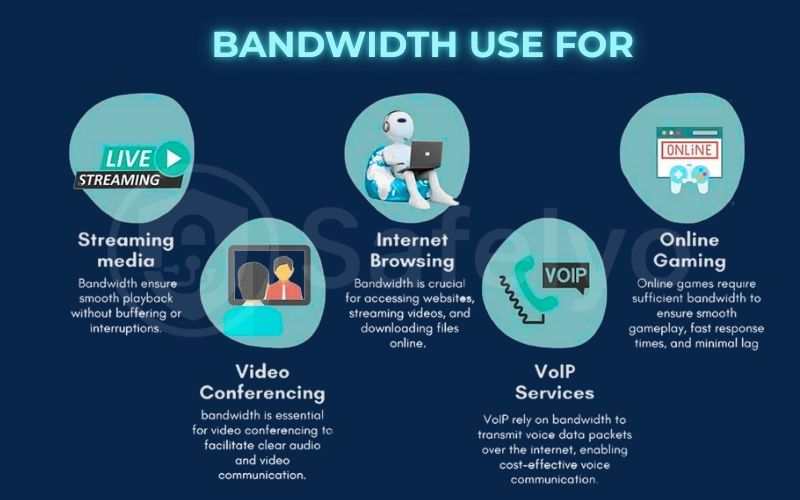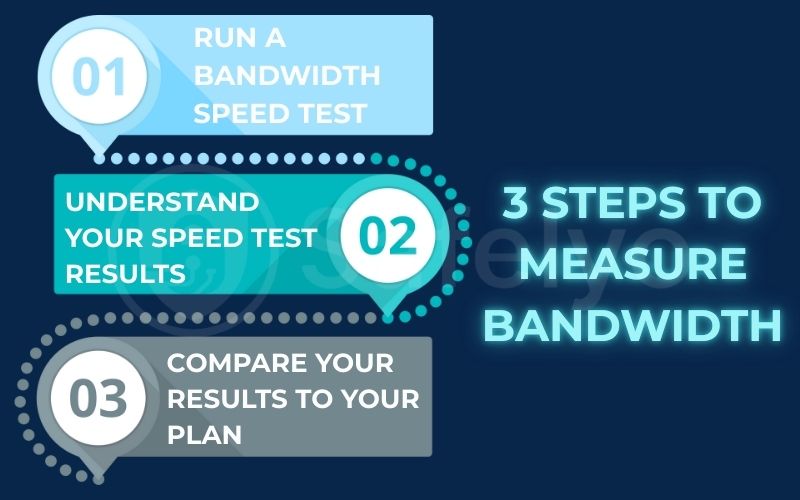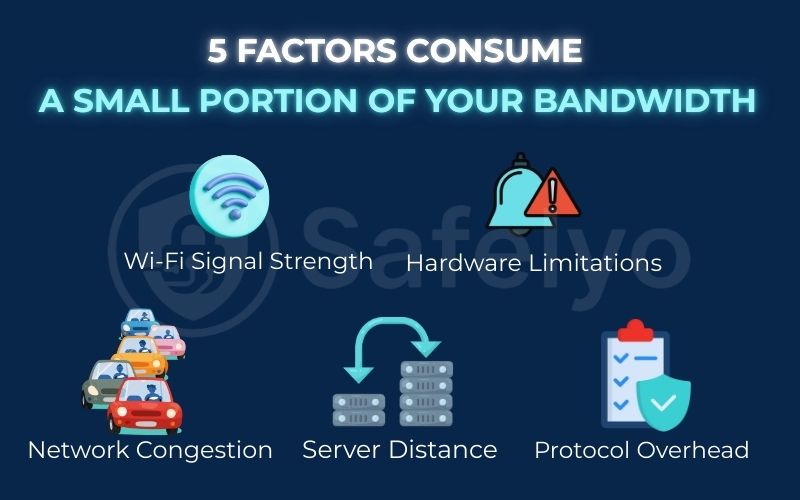You often see terms like “100 Mbps” or “1 Gbps” in internet ads and on speed test results. But have you ever wondered how is the bandwidth of a network measured? What do those numbers truly mean for your daily streaming and browsing?
In a world that runs on fast connections, understanding these metrics is the first step to knowing if you’re getting the internet speed you pay for. As tech experts who have diagnosed countless slow network connection issues, we know that this confusion is the biggest barrier to solving common problems. This knowledge isn’t just for network engineers; it’s a fundamental skill for any internet user.
In this simple guide, you will discover:
- What is bandwidth, and how does it differ from internet speed? Explained with a simple analogy.
- The crucial difference between bits vs bytes (and why your download speed always looks slower).
- A practical, step-by-step guide on how to measure bandwidth yourself in minutes.
- How to read your speed test results to truly understand your connection’s performance.
Stop being in the dark about your internet service. Let me decode the numbers and empower you to understand the connection you pay for.
1. What is bandwidth?
Let’s start with the simplest definition: Bandwidth is the maximum capacity of your network connection to move data over a specific period, usually one second. It’s not the same as internet speed, although the two are closely related.
The easiest way I explain this to people is to think of your internet connection as a highway.
- Bandwidth is the number of lanes on the highway. A massive 8-lane superhighway (high bandwidth) has the capacity to handle far more cars at once than a narrow 2-lane country road (low bandwidth).
- Internet speed (or more accurately, throughput) is the speed at which the cars are actually traveling. Even on an 8-lane highway, if there’s a traffic jam (network congestion), the cars will move slowly.
So, what is bandwidth‘s main benefit? Having more “lanes” means more data can travel simultaneously without slowing things down for everyone else. This is crucial in a modern home where one person might be streaming a 4K movie, another is on a video call, and a third is downloading a large game.
A high-bandwidth connection allows all these activities to happen at once, each in its own “lane,” without causing a digital traffic jam. While bandwidth is about how much data can be sent, speed is about how fast that data is actually moving at any given moment.

2. Bandwidth measurement units
The language of internet speed can be confusing. It’s filled with acronyms and terms that all sound similar but mean very different things. Let’s break down these bandwidth measurement units so you can read them with confidence.
2.1. Bits vs. Bytes
This is, without a doubt, the single most confusing part for most people, but understanding it is a true “aha!” moment.
- Bit (b): A bit is the smallest possible unit of digital data – a single 1 or 0. Internet service providers always advertise and measure bandwidth in bits per second.
- Byte (B): A Byte is a group of 8 bits. The size of files on your computer (photos, documents, videos) is almost always measured in Bytes.
To explain this, I always use a delivery analogy. Imagine you’re receiving a shipment of bricks.
- Bits are the individual bricks. Your internet provider proudly tells you they can deliver 100 million individual bricks per second (megabits per second).
- Bytes are the pre-packaged boxes, each containing 8 bricks. When you download a file, your web browser shows you the download speed by counting how many boxes it’s receiving per second (MegaBytes per second).
This is the secret! This is why your “100 Mbps” internet plan only shows a download speed of around “12.5 MB/s” in your browser. Your connection isn’t slower; your browser is just counting in bigger units (boxes instead of bricks).
The math is simple: 100 Megabits / 8 = 12.5 Megabytes. Understanding the bits vs bytes difference is the key to accurately interpreting your internet speed.
2.2. Kbps, Mbps vs Gbps
Now that we understand the basic unit (bits), the rest is just about scale, using standard metric prefixes: Kilo (thousand), Mega (million), and Giga (billion).
- Kbps (Kilobits per second): Thousands of bits per second. This was the speed of old dial-up modems. Today, it’s considered extremely slow.
- Mbps (Megabits per second): Millions of bits per second. This is the current standard for most home broadband and mobile internet connections.
- Gbps (Gigabits per second): Billions of bits per second. This represents the top tier of modern internet, typically delivered via fiber optic cables. One Gbps is equal to 1,000 Mbps.
Here’s a simple table to put the Mbps vs Gbps comparison into perspective:
| Unit | Full Name | Equivalent | Common Use Case |
|---|---|---|---|
| Mbps | Megabits per second | 1,000,000 bps | Streaming HD video, online gaming |
| Gbps | Gigabits per second | 1,000 Mbps | Streaming 4K video, multiple heavy users, large file transfers |
3. How to measure bandwidth in a practical 3-step guide
Now that you understand the language, it’s time to become a scientist and measure your own network connection. This simple, three-step process will give you a clear picture of your actual network performance.
Quick guide
1. Run a bandwidth speed test
2. Read the results
3. Compare to your plan
3.1. Step 1: Run a bandwidth speed test
The easiest and most common way to test bandwidth speed is by using a free online tool. These tools work by sending a data file from a nearby server to your computer (download) and then sending it back (upload), measuring the speed of that transfer.
Recommended tool: While there are many bandwidth test tools, the industry standard is Speedtest.net by Ookla. It’s reliable, has servers all over the world, and provides the key metrics you need.
Tips for the most accurate results:
I always follow these steps myself before running a test to ensure I’m measuring my connection’s true potential, not my Wi-Fi’s limitations.
- Use a wired connection if possible. Plug your computer directly into your router with an Ethernet cable. This eliminates Wi-Fi signal strength as a variable.
- Close other applications and tabs. Any other program using the internet – like a streaming service, a cloud backup, or even just extra browser tabs – will compete for bandwidth and skew your results.
- Pause all other network activity. Make sure no one else in your house is streaming a 4K movie or downloading a large game while you run the test.
Once you’re ready, simply go to the website and click the big “GO” button.
3.2. Step 2: Understand your speed test results
After about a minute, you’ll be presented with a dashboard of numbers. Here’s how to decode them.
- DOWNLOAD (Mbps): This is the most important number for most people. It’s the speed at which you receive data from the internet. A high download speed is crucial for smooth video streaming, fast web browsing, and downloading files. The higher, the better.
- UPLOAD (Mbps): This is the speed at which you send data to the internet. A high upload speed is critical for clear video calls (like on Zoom or Teams), competitive online gaming, and uploading large files to cloud storage. The higher, the better.
- PING (Latency – ms): This is your connection’s reaction time, measured in milliseconds. It’s not about speed but responsiveness. A low ping is essential for online gaming, where split-second reactions matter. The lower, the better. (Anything under 50ms is considered great for most activities.)
3.3. Step 3: Compare your results to your plan
The final step is the reality check. Take the download speed number you just measured (e.g., 85 Mbps) and compare it to the speed advertised in your internet plan (e.g., 100 Mbps).
It’s normal to see a result that’s about 80-95% of your plan’s advertised speed. If your result is dramatically lower, it’s a concern. For example, if you pay for 100 Mbps but are only getting 30 Mbps, something is clearly wrong. This indicates an issue with your network connection.

Read more:
4. Theoretical vs. actual bandwidth: Why you never get the advertised speed
After running a speed test, a common question I hear is, “I pay for 100 Mbps, so why did my test only show 92 Mbps? Am I being ripped off?” The answer is almost always no. This discrepancy highlights the crucial difference between theoretical and actual bandwidth.
- Theoretical Bandwidth: This is the maximum, perfect-world speed that your internet provider advertises. Think of it as the speed limit on our highway analogy. It’s the highest capacity the connection is designed to handle under ideal laboratory conditions.
- Actual Bandwidth (Throughput): This is the speed you actually experience in the real world. It’s the average speed of the cars on the highway during rush hour. Throughput is what you measure with a speed test, and it will always be slightly lower than the theoretical bandwidth.
It’s not a bait-and-switch; it’s just the physics of how networks operate. Several factors will always consume a small portion of your bandwidth or affect your real-world throughput:
- Network Congestion: Just like a real highway, if too many people in your neighborhood are using the internet at the same time (especially in the evenings), the overall speed can slow down.
- Hardware Limitations: An old router, a slow computer, or an outdated network card can create a bottleneck that prevents you from reaching top speeds.
- Wi-Fi Signal Strength: The farther you are from your router and the more walls the signal has to pass through, the lower your actual speed will be.
- Server Distance: The speed test measures the connection to a nearby server. Your speed when connecting to a server on the other side of the world will naturally be slower.
- Protocol Overhead: The very act of sending and receiving data requires extra “header” information for routing and error-checking, which uses up a small percentage of your bandwidth.
Understanding that your actual speed will be a little less than the advertised number is key to having realistic expectations about your network connection.

5. Beyond bandwidth: Other metrics of network performance
While bandwidth is the metric everyone talks about, it’s not the only factor that determines the quality of your internet experience. Answering the question of how network performance is measured requires looking at a few other key metrics that work alongside bandwidth: Latency, Jitter, and Packet Loss.
Think of it this way: A wide, 8-lane highway (high bandwidth) is great, but if the road is full of potholes and stoplights, the driving experience will still be terrible. These other metrics measure the “smoothness” of your connection.
Latency (Ping)
As we covered in the speed test section, this is your connection’s reaction time. For activities that require instant feedback, like online gaming or stock trading, low latency is often more important than high bandwidth. A connection with 50 Mbps and 20ms ping will feel much better for gaming than a 500 Mbps connection with 200ms ping.
Jitter
This is the variation in your latency over time. A stable connection has very low jitter, meaning the response time is consistent. High jitter is what causes that annoying stuttering or “choppy” audio in video calls and online games. Even if your average ping is low, high jitter can make a connection feel unstable.
Packet Loss
Data travels across the Internet in small bundles called “packets.” Packet loss occurs when some of these packets fail to reach their destination. A small amount of packet loss is normal and can be corrected. However, high packet loss will cause noticeable issues. You might experience dropped video call frames, lag spikes in games, or slow-loading web pages. This happens because your computer has to re-request the missing data.
The bottom line
A truly great network connection isn’t just about having high bandwidth (a wide highway). It’s a combination of high bandwidth, low latency, low jitter, and minimal packet loss (a smooth, clear road).
6. FAQ about how is the bandwidth of a network measured
Diving into the world of network metrics can bring up a few specific questions. Here are quick, direct answers to some of the most common ones.
How is network bandwidth measured?
Network bandwidth is measured in bits per second (bps). For modern connections, this is typically expressed in Megabits per second (Mbps) or Gigabits per second (Gbps). The most common way to measure your connection’s actual performance is by using online bandwidth test tools like Speedtest.net, which measure your download and upload speeds.
How to evaluate network bandwidth?
To evaluate your bandwidth, first run a speed test to get your actual download and upload speeds. Then, compare these results to the speeds advertised in your internet plan. A good connection should consistently deliver 80-95% of the advertised speed. For a complete evaluation, you should also consider other metrics like latency (ping), jitter, and packet loss, as high bandwidth with poor stability is still a bad connection.
How to calculate bandwidth in a network?
For practical, real-world purposes, you don’t “calculate” your bandwidth; you measure it using bandwidth test tools. For theoretical calculations, like in a computer science context, the basic formula is Bandwidth = Amount of Data (in bits) / Time (in seconds). However, real-world factors like network congestion make direct measurement the only truly accurate method.
How much bandwidth do I need?
For general browsing and HD video streaming for one or two people, 25-50 Mbps is often sufficient. For households with multiple users, 4K streaming, and online gaming, a plan of 100 Mbps or more is recommended for a smooth experience.
How is the bandwidth of a network measured in Codehs?
This question likely refers to the theoretical concept taught in computer science platforms like CodeHS. In that context, bandwidth is calculated as the amount of data (in bits) that can be transferred over a period of time (in seconds). A common formula is Bandwidth = Data / Time. For example, if a network can transfer 8 million bits in 1 second, its bandwidth is measured as 8 Mbps.
7. Conclusion
Understanding how the bandwidth of a network is measured is no longer a complex mystery but an empowering skill for every internet user. By grasping a few key concepts and analogies, you can decode the language of internet speed. This knowledge helps you become a more informed consumer. You’ll be fully aware of what you’re paying for and how your connection is performing.
Here are the most important takeaways from this guide:
- Bandwidth is capacity, not speed. It’s measured in bits per second (Mbps, Gbps) and represents the maximum capacity of your connection.
- Don’t confuse bits and bytes. Your internet plan is sold in megabits (Mbps), while your file download speeds are shown in MegaBytes per second (MB/s). Remember the 8-to-1 ratio.
- A speed test is your best friend. The easiest way to measure bandwidth performance is to use a tool like Speedtest.net and understand the three key results: download, upload, and ping.
- Real-world speed will always be slightly lower. The difference between theoretical and actual bandwidth is normal and caused by factors like network congestion and Wi-Fi limitations.
You are now equipped with the knowledge to read a speed test result, understand the terms on your internet bill, and accurately assess whether your network connection is truly delivering. If your test results are lower than you expect, it’s time to start troubleshooting. Explore our detailed guide on how to increase your bandwidth to find actionable solutions in the Tech How-To Simplified section here on Safelyo.






